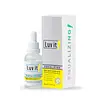What's inside
What's inside
 Key Ingredients
Key Ingredients

 Benefits
Benefits

 Concerns
Concerns

 Ingredients Side-by-side
Ingredients Side-by-side

Water
Skin ConditioningOryza Sativa Bran Water
MaskingNiacinamide
SmoothingGlycerin
HumectantButylene Glycol
HumectantSodium PCA
HumectantTranexamic Acid
AstringentSodium Hyaluronate
HumectantGlycolic Acid
BufferingLactic Acid
Buffering3-O-Ethyl Ascorbic Acid
Skin ConditioningGlutathione
Alpha-Arbutin
AntioxidantGlycyrrhiza Glabra Root Extract
BleachingPersea Gratissima Oil
Skin ConditioningPersea Gratissima Fruit Extract
EmollientOryza Sativa Bran Oil
EmollientCamellia Sinensis Leaf Extract
AntimicrobialInositol
HumectantTaurine
BufferingBetaine
HumectantZinc Gluconate
Skin ConditioningZinc PCA
HumectantCitrus Aurantium Tachibana Peel Extract
HumectantPaeonia Suffruticosa Root Extract
Skin ProtectingMelatonin
AntioxidantPhenoxyethanol
PreservativeHydroxyethylcellulose
Emulsion StabilisingBeta-Alanine
HumectantPolysorbate 20
EmulsifyingEthylhexylglycerin
Skin ConditioningTriethanolamine
BufferingTetrasodium EDTA
Sodium Benzoate
MaskingWater, Oryza Sativa Bran Water, Niacinamide, Glycerin, Butylene Glycol, Sodium PCA, Tranexamic Acid, Sodium Hyaluronate, Glycolic Acid, Lactic Acid, 3-O-Ethyl Ascorbic Acid, Glutathione, Alpha-Arbutin, Glycyrrhiza Glabra Root Extract, Persea Gratissima Oil, Persea Gratissima Fruit Extract, Oryza Sativa Bran Oil, Camellia Sinensis Leaf Extract, Inositol, Taurine, Betaine, Zinc Gluconate, Zinc PCA, Citrus Aurantium Tachibana Peel Extract, Paeonia Suffruticosa Root Extract, Melatonin, Phenoxyethanol, Hydroxyethylcellulose, Beta-Alanine, Polysorbate 20, Ethylhexylglycerin, Triethanolamine, Tetrasodium EDTA, Sodium Benzoate
Water
Skin ConditioningAlpha-Arbutin
AntioxidantPhenethyl Alcohol
MaskingHydroxyethylcellulose
Emulsion StabilisingPropylene Glycol
HumectantAloe Barbadensis Leaf Juice Powder
Skin ConditioningTriethanolamine
Buffering1,2-Hexanediol
Skin ConditioningCitric Acid
BufferingGlycerin
HumectantSodium Acetate
BufferingCitrus Grandis Peel Water
HumectantSodium PCA
HumectantIsopropyl Alcohol
SolventPentylene Glycol
Skin ConditioningCellulose
AbsorbentErythritol
HumectantCarrageenan
Sodium Acetylated Hyaluronate
HumectantSodium Hyaluronate
HumectantXanthan Gum
EmulsifyingSodium Hyaluronate Crosspolymer
HumectantEthylhexylglycerin
Skin ConditioningHydrolyzed Sodium Hyaluronate
Skin ConditioningPhenoxyethanol
PreservativeWater, Alpha-Arbutin, Phenethyl Alcohol, Hydroxyethylcellulose, Propylene Glycol, Aloe Barbadensis Leaf Juice Powder, Triethanolamine, 1,2-Hexanediol, Citric Acid, Glycerin, Sodium Acetate, Citrus Grandis Peel Water, Sodium PCA, Isopropyl Alcohol, Pentylene Glycol, Cellulose, Erythritol, Carrageenan, Sodium Acetylated Hyaluronate, Sodium Hyaluronate, Xanthan Gum, Sodium Hyaluronate Crosspolymer, Ethylhexylglycerin, Hydrolyzed Sodium Hyaluronate, Phenoxyethanol
Ingredients Explained
These ingredients are found in both products.
Ingredients higher up in an ingredient list are typically present in a larger amount.
Alpha-Arbutin is made from hydroquinone and glucose. It may also be derived from the fermentation of soybeans.
This ingredient an antioxidant, meaning it helps protect your skin cells against damage.
Studies show this ingredient helps improve hyperpigmentation and fade discoloration.
Alpha-Arbutin may be used with other ingredients that help with hyperpigmentation. These ingredients include retinol, Vitamin C, niacinamide, and tranexamic acid.
Learn more about Alpha-ArbutinEthylhexylglycerin (we can't pronounce this either) is commonly used as a preservative and skin softener. It is derived from glyceryl.
You might see Ethylhexylglycerin often paired with other preservatives such as phenoxyethanol. Ethylhexylglycerin has been found to increase the effectiveness of these other preservatives.
Glycerin is already naturally found in your skin. It helps moisturize and protect your skin.
A study from 2016 found glycerin to be more effective as a humectant than AHAs and hyaluronic acid.
As a humectant, it helps the skin stay hydrated by pulling moisture to your skin. The low molecular weight of glycerin allows it to pull moisture into the deeper layers of your skin.
Hydrated skin improves your skin barrier; Your skin barrier helps protect against irritants and bacteria.
Glycerin has also been found to have antimicrobial and antiviral properties. Due to these properties, glycerin is often used in wound and burn treatments.
In cosmetics, glycerin is usually derived from plants such as soybean or palm. However, it can also be sourced from animals, such as tallow or animal fat.
This ingredient is organic, colorless, odorless, and non-toxic.
Glycerin is the name for this ingredient in American English. British English uses Glycerol/Glycerine.
Learn more about GlycerinHydroxyethylcellulose is used to improve the texture of products. It is created from a chemical reaction involving ethylene oxide and alkali-cellulose. Cellulose is a sugar found in plant cell walls and help give plants structure.
This ingredient helps stabilize products by preventing ingredients from separating. It can also help thicken the texture of a product.
This ingredient can also be found in pill medicines to help our bodies digest other ingredients.
Learn more about HydroxyethylcellulosePhenoxyethanol is a preservative that has germicide, antimicrobial, and aromatic properties. Studies show that phenoxyethanol can prevent microbial growth. By itself, it has a scent that is similar to that of a rose.
It's often used in formulations along with Caprylyl Glycol to preserve the shelf life of products.
Sodium Hyaluronate is hyaluronic acid's salt form. It is commonly derived from the sodium salt of hyaluronic acid.
Like hyaluronic acid, it is great at holding water and acts as a humectant. This makes it a great skin hydrating ingredient.
Sodium Hyaluronate is naturally occurring in our bodies and is mostly found in eye fluid and joints.
These are some other common types of Hyaluronic Acid:
Learn more about Sodium HyaluronateSodium PCA is the sodium salt of pyroglutamic acid. It is naturally occurring in our skin's natural moisturizing factors where it works to maintain hydration.
The PCA stands for pyrrolidone carboxylic acid, a natural amino acid derivative.
This ingredient has skin conditioning, anti-inflammatory, and humectant properties. Humectants help hydrate your skin by drawing moisture from the air. This helps keep your skin moisturized.
Learn more about Sodium PCATriethanolamine is an emulsifier and pH adjuster. It is created using ethylene oxide and ammonia. This gives Triethanolamine a nitrogen core and a similar scent to ammonia.
As an emulsifier, it prevents ingredients from separating and enhances texture by adding volume to a product.
PH adjusters are common in cosmetic products. The pH of a product can affect the effectiveness of other ingredients. A product with a high pH may also irritate the skin.
Learn more about TriethanolamineWater. It's the most common cosmetic ingredient of all. You'll usually see it at the top of ingredient lists, meaning that it makes up the largest part of the product.
So why is it so popular? Water most often acts as a solvent - this means that it helps dissolve other ingredients into the formulation.
You'll also recognize water as that liquid we all need to stay alive. If you see this, drink a glass of water. Stay hydrated!
Learn more about Water